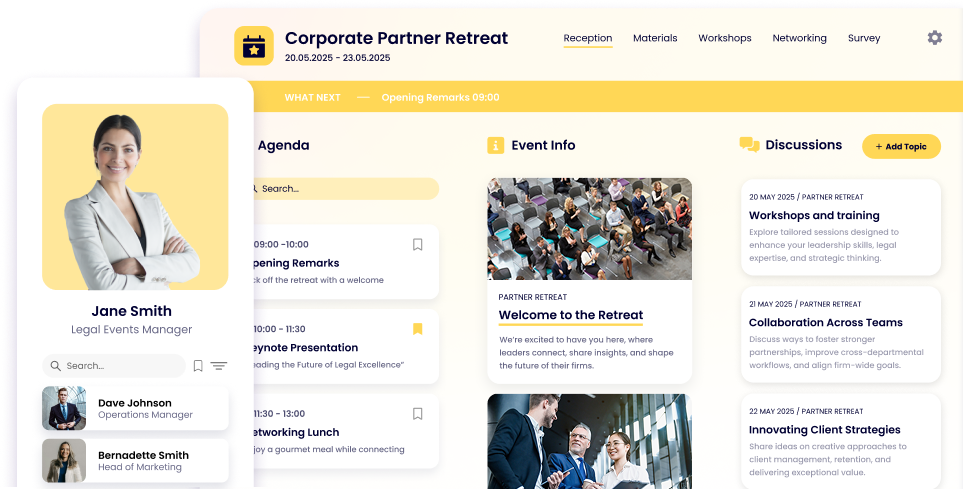Maximize Event Success: The Ultimate Guide to Advanced Attendee Tracking

Lisa Broom | Head of Marketing
Tracking attendance at events is crucial for optimizing the success of any event. That’s true whether you’re hosting a corporate conference, a large festival, or a small workshop. No matter what, knowing who attends and how they engage with your event can provide insights that will drive serious growth.
In the following guide, we explain the importance of attendance tracking, the best technological solutions to do the job, and the kinds of options you have to track attendance. We’ll also go over typical challenges you might run into.
No matter what events solution you’re looking for, we cover it below!
Importance of Attendance Tracking
![]()
Tracking attendance is a critical component of event management. It provides a wealth of benefits that can significantly enhance the planning, execution, and post-event analysis of any gathering.
Here’s an in-depth look at why attendee tracking should be a priority for event organizers.
Improved planning and organization
Effective attendee tracking enables better logistics planning, ensuring that everything from seating arrangements to catering needs is appropriately managed. Knowing the number of attendees helps in:
- Accurate Attendance Forecasting: Predicting the number of attendees accurately allows organizers to prepare adequately and avoid over or under-provisioning resources.
- Improved Logistics Planning: Detailed attendee data helps in arranging appropriate seating, scheduling sessions, and organizing break times efficiently.
- Smooth Check-In Processes: Advanced tracking methods, such as using an event attendance tracker app, can streamline the check-in process, reducing wait times and enhancing the attendee experience.
Resource allocation
Properly tracking attendance helps in the efficient distribution of staff and materials based on the number of attendees. This ensures that resources are used optimally:
- Efficient Staff and Material Distribution: Allocate staff to high-traffic areas and ensure that materials like brochures or food are adequately stocked where needed.
- Optimal Use of Venue Space: Utilize the venue space effectively, avoiding overcrowded or underutilized areas.
- Reduced Resource Wastage: By matching resources to attendee numbers, wastage is minimized, making the event more sustainable and cost-effective.
Improved attendee experience
Enhancing the attendee experience is crucial for event success. Tracking attendance allows for:
- Streamlined Check-In Processes: Use of technologies like RFID attendee tracking or mobile apps can make check-in quick and hassle-free.
- Personalized Attendee Experiences: Data collected through event attendance tracking can be used to tailor experiences, such as personalized session recommendations or targeted networking opportunities.
- Enhanced Engagement: Engaging attendees through data-driven interactions increases their satisfaction and involvement in the event.
Data collection and analysis
One of the most significant advantages of tracking attendance is the ability to gather and analyze data. This data can provide valuable insights for future events:
- Demographic and Behavioral Data Collection: Collect information on attendee demographics and behavior to understand your audience better.
- Attendance Pattern Analysis: Analyze which sessions or activities were most popular, helping to inform future event planning.
- Data-Driven Decision Making: Use the collected data to make informed decisions about event content, layout, and marketing strategies.
Increased security and safety
Tracking attendee movements enhances event security and safety:
- Attendee Movement Monitoring: Keep track of where attendees are within the venue to ensure safety and security.
- Effective Crowd Control: Use data to manage crowd flow and prevent overcrowding in specific areas.
- Compliance with Safety Regulations: Ensure that all safety protocols are met, protecting attendees and complying with legal requirements.
Post-event feedback and follow-up
Facilitating feedback collection and follow-up after the event is essential for continuous improvement:
- Post-Event Survey Facilitation: Use attendance data to send targeted surveys to attendees, gathering feedback on their experience.
- Enhanced Post-Event Communication: Keep in touch with attendees, providing updates and information about future events.
- Continuous Improvement Support: Use feedback to make necessary adjustments and improvements for upcoming events.
Compliance and reporting
Accurate attendance tracking helps in meeting legal and regulatory requirements:
- Compliance with Legal Requirements: Ensure that your event complies with all relevant laws and regulations.
- Accurate Records for Audits: Maintain detailed records of attendance for audit purposes.
- Transparent Event Management: Provide clear and transparent reports to stakeholders, demonstrating the success and compliance of the event.
Revenue management
Understanding attendance numbers directly impacts revenue management:
- Ticket Sales and Attendance Tracking: Monitor ticket sales and actual attendance to gauge financial success.
- ROI Measurement: Measure the return on investment by analyzing attendance data against costs.
- Dynamic Pricing Support: Implement dynamic pricing strategies based on real-time attendance data to maximize revenue.
Sponsor and exhibitor benefits
Providing detailed attendance reports to sponsors and exhibitors can enhance their ROI:
- Detailed Attendance Reports for Sponsors: Show sponsors the value they received through detailed attendance analytics.
- Enhanced Sponsor ROI: Use data to demonstrate the effectiveness of sponsorship packages.
- Exhibitor Engagement Analytics: Provide exhibitors with insights into attendee interactions, helping them measure their success.
Marketing insights
Attendee tracking offers valuable insights for future marketing efforts:
- Target Audience Identification: Use attendance data to identify key audience segments.
- Marketing Campaign Effectiveness Measurement: Measure how effective your marketing campaigns were in driving attendance.
- Future Event Promotion Enhancement: Use insights to refine and improve promotional strategies for future events.
Incorporating advanced attendee tracking methods, such as an event attendance tracker app, RFID attendee tracking, or even low-tech methods like manual check-ins and spreadsheets, can significantly enhance the success of your event.
By prioritizing attendee tracking, you can ensure better planning, improved attendee experiences, and valuable data insights for future events. That’s what makes it a key element of any event marketing plan.
Technologies Used in Attendance Tracking
![]()
When it comes to event attendee tracking, you have so many technological aids to work with. Not every solution makes sense for every event, but finding the best method to track attendees at an event begins with knowing what tools you have at your disposal.
We’ve outlined your best options below, including the features that make them a good choice for some situations.
QR codes
- Easy to generate and scan
- Cost-effective and versatile
- Integrates with various event management systems
Mobile apps
- Real-time tracking and updates
- Interactive features for attendee engagement
- Seamless check-in and communication
Biometrics
- High security through unique identifiers
- Reduces ticket fraud risk
- Enhances attendee convenience
Manual check-Ins
- Simple and straightforward
- Suitable for smaller events
- No advanced technology required
Digital check-ins
- Quick and efficient processing
- Reduces wait times and manual errors
- Integrates with event management software
Hybrid methods
- Combines various technologies for flexibility
- Enhances accuracy and reliability
- Adapts to different event sizes and types
Types of Event Attendance Tracking
![]()
Choosing the right method for tracking event attendance is crucial for ensuring a seamless and successful event. Different events may require different tracking methods based on their size, nature, and specific needs. For instance, a corporate event app might be perfect for a large expo while having social media check-ins could be a better fit for an ongoing art exhibit.
Event Apps
- Advantages: Comprehensive support and functionality.
- Disadvantages: May require some familiarity.
Mechanical counters
- Advantages: Simple and low-cost.
- Disadvantages: Limited data collection.
Self-service kiosks
- Advantages: Fast and reduces staffing needs.
- Disadvantages: Requires investment in hardware.
Social media integration
- Advantages: Enhances engagement and easy sharing.
- Disadvantages: Privacy concerns and requires online presence.
Magnetic stripe cards
- Advantages: Secure and reusable.
- Disadvantages: Requires card readers and potential technical issues.
Digital ticketing
- Advantages: Convenient and eco-friendly.
- Disadvantages: Depends on attendee smartphone usage.
Online registration systems
- Advantages: Streamlines pre-event planning.
- Disadvantages: May require internet access.
Attendance tracking software
- Advantages: Comprehensive data collection and real-time insights.
- Disadvantages: Can be expensive and needs tech support.
RFID wristbands
- Advantages: Fast, secure, and durable.
- Disadvantages: Higher cost and requires RFID readers.
Facial recognition technology
- Advantages: High security and quick processing.
- Disadvantages: Privacy concerns and requires advanced technology .
Tracking Attendance for Virtual Events
![]()
Tracking attendance for virtual events presents unique challenges and opportunities. By leveraging technology, you can ensure accurate attendance data and enhance the virtual experience for your attendees. One effective method for virtual attendance tracking is the use of QR codes and barcodes.
QR Codes and Barcodes
QR codes and barcodes offer a simple yet powerful solution for integrating with virtual platforms. They are easy for attendees to scan and check in, making the process seamless and efficient. Using an event app builder, you can build QR codes and barcodes into the flow, making them extremely easy and effortless for attendees to use.
This method not only simplifies the check-in process but also provides accurate data for virtual engagement. With precise attendance tracking, you can gather valuable insights into attendee behavior, engagement levels, and overall event success, enabling you to make informed decisions for future virtual events.
Low-Tech Methods of Attendance Tracking
![]()
A great event attendance tracker doesn’t have to come in the form of an app or a code. Sometimes, low-tech but highly reliable methods offer easy solutions.
Typically, this requires a bit of a trade-off. Turning the data into a highly workable, digital form might take more time. Even if you run event attendance tracking with Excel, you’ll still need to have someone manually inputting the information. And the solutions rarely scale easily. But there are plenty of events where these trade-offs make sense. So, let’s go over your low-tech methods of attendance tracking.
Spreadsheets (Event Attendance Tracking in Excel)
- Simple and accessible
- Suitable for small events
- Manual data entry can be time-consuming and error-prone
Manual Check-Ins
- Personal interaction with attendees
- No need for technology
- Less efficient for larger events
Challenges in Attendance Tracking
As with anything, there are several challenges that organizers must manage if they want to successfully track attendance. Addressing these challenges head-on will help maximize the benefits of attendance tracking while minimizing potential issues.
Privacy concerns
- Protecting Attendee Data: Safeguarding attendees’ personal information is paramount. Ensure that all data collected is stored securely and accessed only by authorized personnel.
- Compliance with Data Protection Regulations: Adhere to all relevant data protection laws, such as GDPR, to avoid legal repercussions and maintain attendee trust.
Ensuring accuracy
- Avoiding Manual Errors and Technical Glitches: Implement automated systems where possible to reduce human error. Regularly test and maintain your tracking technology to prevent glitches.
- Regular Audits and Checks: Conduct frequent audits to verify the accuracy of attendance data and rectify any discrepancies promptly.
Managing costs
- Balancing Technology Investments with Budget Constraints: Choose technologies that provide the best value for your budget. An event attendance tracker app should offer essential features without excessive costs.
- Opting for Cost-Effective Solutions Without Compromising Quality: Look for affordable yet reliable attendance tracking options that do not compromise on functionality or data security.
Handling technical issues
- Ensuring Reliable Tech Support: Have a dedicated technical support team on standby to address any issues that arise during the event.
- Preparing for Potential System Failures: Develop contingency plans to handle system outages or failures, ensuring minimal disruption to the event.
Integrating with existing systems
- Compatibility with Current Event Management Tools: Ensure that your attendance tracking system seamlessly integrates with your existing event management software.
- Smooth Data Transfer and Integration: Facilitate easy data transfer between systems to maintain consistency and accuracy across all platforms.
Real-time data processing
- Ensuring Quick and Accurate Data Updates: Use advanced tracking technologies that provide real-time updates to keep data current.
- Handling Large Volumes of Data Efficiently: Implement robust systems capable of processing large datasets quickly and accurately.
Ensuring user adoption
- Encouraging Attendees to Use New Technologies: Clearly communicate the benefits of using the event attendance tracking app to attendees.
- Providing Clear Instructions and Support: Offer easy-to-follow guides and support to help attendees navigate new tracking technologies.
Data security risks
- Implementing Robust Security Measures: Use encryption and other security protocols to protect attendee data.
- Regularly Updating and Monitoring Systems: Keep your tracking systems updated with the latest security patches and monitor for any potential breaches.
Compliance with regulations
- Staying Updated with Legal Requirements: Continuously review and comply with all relevant regulations governing data collection and privacy.
- Ensuring All Data Practices Are Compliant: Audit your data practices regularly to ensure full compliance with legal standards.
Analyzing large datasets
- Using Advanced Tools for Data Analysis: Leverage sophisticated analytics tools to extract valuable insights from attendance data.
- Extracting Meaningful Insights from Complex Data: Focus on interpreting data in ways that provide actionable insights for future event planning.
Addressing attendee resistance
- Communicating Benefits Clearly: Highlight how the attendance tracking app enhances the overall event experience for attendees.
- Offering Incentives for Participation: Provide incentives, such as exclusive content or rewards, to encourage attendees to use the tracking system.
Maintaining system scalability
- Ensuring Systems Can Handle Varying Event Sizes: Choose scalable solutions that can accommodate different event sizes and complexities.
- Planning for Future Growth and Changes: Ensure your tracking system can evolve with your event needs, supporting future expansions and new features.
By understanding and addressing these challenges, event organizers can effectively implement advanced conference attendee tracking systems, ensuring a seamless and successful event experience.
How an Event Attendee Tracking App can help you overcome those obstacles?
Using an event attendee tracking app can significantly mitigate the challenges associated with attendance tracking. Here’s how such an app can help address common obstacles:
Privacy concerns
- Protecting attendee data: An attendee tracking app offers robust security features, including encryption and access controls, ensuring that all personal data is securely stored and accessed only by authorized personnel.
- Compliance with data protection regulations: These apps are designed to comply with data protection laws like GDPR, providing tools to manage consent and ensure that your data handling practices meet legal standards.
Ensuring accuracy
- Avoiding manual errors and technical glitches: Automating attendance tracking through an app reduces the likelihood of human errors and technical issues. Regular updates and maintenance features help keep the system glitch-free.
- Regular audits and checks: The app can automatically conduct audits and checks to verify data accuracy, promptly identifying and correcting any discrepancies.
Managing costs
- Balancing technology investments with budget constraints: Event attendee tracking apps offer various pricing plans, allowing you to choose a solution that fits your budget without sacrificing essential features.
- Opting for cost-effective solutions without compromising quality: These apps provide reliable and affordable attendance tracking options, ensuring high functionality and data security.
Handling technical issues
- Ensuring reliable tech support: Most event tracking apps come with dedicated technical support teams available to address any issues that arise during the event.
- Preparing for potential system failures: The apps often include contingency features, such as offline modes and data backup, to handle system outages with minimal disruption.
Integrating with existing systems
- Compatibility with current event management tools: Event tracking apps are designed to seamlessly integrate with your existing event management software, ensuring smooth data transfer and consistency.
- Smooth data transfer and integration: These apps facilitate easy data transfer between systems, maintaining accuracy and reliability across all platforms.
Real-time data processing
- Ensuring quick and accurate data updates: Advanced tracking technologies within the app provide real-time updates, keeping your data current and accurate.
- Handling large volumes of data efficiently: The app’s robust systems can efficiently process large datasets, ensuring quick and accurate data handling.
Ensuring user adoption
- Encouraging attendees to use new technologies: The app clearly communicates the benefits of the tracking system to attendees, increasing adoption rates.
- Providing clear instructions and support: User-friendly interfaces and comprehensive support materials help attendees easily navigate the new technology.
Data security risks
- Implementing robust security measures: Event tracking apps use state-of-the-art encryption and security protocols to protect attendee data from breaches.
- Regularly updating and monitoring systems: These apps ensure your system is always up-to-date with the latest security patches, actively monitoring for any potential security threats.
Compliance with regulations
- Staying updated with legal requirements: Event apps regularly update their compliance features to align with the latest legal requirements.
- Ensuring all data practices are compliant: Regular audits and compliance checks within the app ensure that all data practices adhere to legal standards.
Analyzing large datasets
- Using advanced tools for data analysis: The app provides sophisticated analytics tools to extract valuable insights from attendance data.
- Extracting meaningful insights from complex data: Focused data interpretation tools help you gain actionable insights for future event planning.
Addressing attendee resistance
- Communicating benefits clearly: The app highlights how it enhances the overall event experience, encouraging attendee participation.
- Offering incentives for participation: Offering exclusive content or rewards through the app can motivate attendees to engage with the tracking system.
Maintaining system scalability
- Ensuring systems can handle varying event sizes: The app is scalable, accommodating events of different sizes and complexities.
- Planning for future growth and changes: The app supports future expansions and new features, evolving with your event needs.
By utilizing an event attendee tracking app, event organizers can effectively overcome these obstacles, ensuring a seamless and successful event experience.
Ready to take your event management to the next level? Book a demo of Fliplet to see how our innovative solutions can help you plan and execute outstanding events.
How to Choose an Event Attendance Tracking App
Knowing what is the best way to track attendance at an event comes down to figuring out the needs of your event attendees and of your organization. Aligning the experience of one and the harvestable insights of the other makes the best fit.
With the right analysis, you can track attendance at events in a way that works with the technology and methods available.
Understanding your needs
- Attendee experience: Consider what will make the check-in and attendance process smooth and engaging for your attendees. Features like quick scanning, easy navigation, and real-time updates can significantly enhance their experience.
- Organizational insights: Determine what kind of data you need to collect. This could include attendee demographics, engagement levels, session popularity, and overall event satisfaction. The insights gathered should help you improve future events and demonstrate ROI.
Key Features of an Event Attendance Tracking App
When evaluating different apps, look for the following key features:
- Real-Time Tracking and Reporting:
- Benefits: Allows you to monitor attendance as it happens, making it easier to manage the event dynamically. Real-time data helps in addressing issues promptly and making on-the-spot improvements.
- Integration with Existing Event Management Tools:
- Benefits: Ensures that the new tracking system works seamlessly with your current event management software. This integration facilitates smooth data transfer and reduces the chances of errors.
- User-Friendly Interface for Attendees and Organizers:
- Benefits: A simple and intuitive interface ensures that both attendees and organizers can easily navigate the app. This reduces frustration and enhances overall satisfaction.
What People Discuss in Forums
Forums and online discussions can provide valuable insights into the pros and cons of different event attendance tracking apps. Here are some common points of discussion:
- Usability and Reliability:
- Pros: Users appreciate apps that are easy to use and provide real-time data. Comprehensive features that cover various aspects of event management are also highly valued.
- Cons: Some users find that certain apps can be expensive and occasionally face technical issues. It’s important to balance cost with the reliability and features offered.
- Cost vs. Value:
- Suggestions: Look for apps that offer good customer support and consider trying trial versions before making a purchase. This helps you evaluate if the app meets your needs without a significant upfront investment.
- User Experiences:
- Pros: Many users report positive experiences with apps that offer ease of use and automation. But if your event is fairly small, low-tech solutions feel a bit friendlier.
- Cons: Technical issues and higher costs are common complaints. It’s beneficial to choose an app with a proven track record and responsive customer support to mitigate these concerns.
Final Tips for Choosing the Right App
- Evaluate Multiple Options: Don’t settle for the first app you come across. Compare different apps based on features, user reviews, and pricing.
- Test Trial Versions: Make use of trial versions to get a hands-on experience and see if the app meets your expectations.
- Consider Future Needs: Choose an app that can scale with your events. As your events grow, the app should be able to handle increased data and additional features.
By carefully considering these factors, you can choose an event attendance tracking app that not only meets your current needs but also supports your long-term event management goals.
Conclusion
Effective attendee tracking is essential for maximizing event success. By choosing the right methods and technologies, you can enhance planning, improve attendee experiences, and gain valuable insights. Use this guide to navigate the complex landscape of event attendance tracking and make informed decisions for your next event.
Need an event app builder to make attendee tracking easy? Book a meeting right now to see how Fliplet can help you easily build apps for all your needs.
FAQs
What is attendee tracking, and why is it important?
Attendee tracking involves monitoring who attends an event and how they engage with it. This practice is crucial because it helps organizers plan better, allocate resources efficiently, enhance attendee experiences, and gather valuable data for future events.
What are the benefits of using an event attendance tracker app?
An event attendance tracker app can streamline check-in processes, provide real-time data, enhance security, personalize attendee experiences, and offer detailed insights for post-event analysis and feedback.
What technologies are commonly used for attendance tracking?
Common technologies include QR codes, mobile apps, biometrics, manual check-ins, digital check-ins, hybrid methods, RFID wristbands, facial recognition, and spreadsheets.
How does tracking attendance improve event planning and organization?
Tracking attendance enables accurate forecasting, better logistics planning, and smooth check-in processes. It helps ensure that resources are allocated appropriately, and that the event runs smoothly.
How can attendee tracking enhance the attendee experience?
By using advanced tracking methods, organizers can provide streamlined check-ins, personalized experiences, and increased engagement. This leads to higher attendee satisfaction and involvement.
What data can be collected through attendee tracking?
Attendee tracking can collect demographic and behavioral data, attendance patterns, and feedback. This data is valuable for understanding the audience, improving future events, and making data-driven decisions.
What are the challenges associated with attendee tracking?
Challenges include privacy concerns, ensuring data accuracy, managing costs, handling technical issues, integrating with existing systems, real-time data processing, ensuring user adoption, data security risks, compliance with regulations, analyzing large datasets, addressing attendee resistance, and maintaining system scalability.
How can an event attendee tracking app help overcome these challenges?
An event attendee tracking app offers robust security features, compliance tools, automated systems for accuracy, cost-effective solutions, reliable tech support, seamless integration, real-time updates, user-friendly interfaces, advanced analytics, and scalable solutions to handle different event sizes.
What should I consider when choosing an event attendance tracking app?
Consider the attendee experience, organizational insights needed, real-time tracking and reporting capabilities, integration with existing tools, user-friendly interface, and cost versus value. Testing trial versions and evaluating multiple options are also important.
How does tracking attendance impact revenue management?
Tracking attendance helps monitor ticket sales, measure ROI, implement dynamic pricing, and provide detailed reports to sponsors and exhibitors, enhancing their ROI.
How can attendee tracking ensure event security and safety?
By monitoring attendee movements, managing crowd control, and complying with safety regulations, attendee tracking ensures a secure and safe environment for all participants.
What are some low-tech methods of attendance tracking?
Low-tech methods include spreadsheets and manual check-ins. These methods are suitable for smaller events but may involve more manual data entry and are less efficient for larger events.
. How does attendee tracking facilitate post-event feedback and follow-up?
Tracking attendance enables targeted surveys and enhanced post-event communication, helping organizers gather feedback and make improvements for future events.
What are the benefits of using advanced tools for data analysis in attendee tracking?
Advanced tools for data analysis can extract meaningful insights from complex data, helping organizers make informed decisions and improve future event planning and marketing strategies.



![30 Best Mobile Event Apps and Conference Apps [2024]](https://fliplet.com/wp-content/uploads/2023/02/15-Best-Event-Apps_Thumbnail.png)

